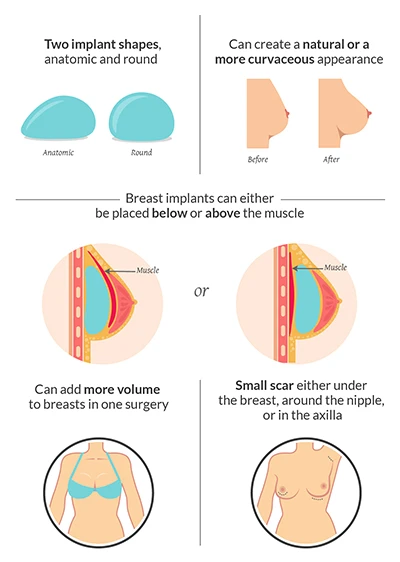Breast implant surgery in Iran
Breast implant surgery in Iran is a cosmetic procedure that involves placing silicone or saline implants into the breasts to increase their size, shape, or fullness. It is commonly performed for:
- Augmentation (enlarging small breasts)
- Reconstruction (after mastectomy or other breast surgery)
- Correction of breast asymmetry
Type of breast augmentation surgery
- Breast prosthesis surgery: to enlarge small breasts
- Breast prosthesis surgery with lift: to enlarge drooping breasts
Cost of Breast implant surgery in Iran
| Breast implant surgery type | Surgery Price | Staying in Tehran |
| Breast prosthesis surgery | 2200 USD | 7 days |
| Breast prosthesis surgery with lift | 2800 USD | 9 days |
| Breast Reconstruction Surgery | Price calculation | – |
| Correction of breast asymmetry | Price calculation | – |
The surgery price includes the cost of the surgeon’s fee and one night’s stay in the hospital
other costs for Breast implant surgery in Iran
The cost of blood test + chest ultrasound + purchase of medicine is about 60 dollars
The cost of a medical bra is about 60 dollars
If you are traveling alone, you can use the nursing services at the hotel
The cost of transportation and translator is free
Types of Implants
- Silicone implants: Filled with a silicone gel, providing a more natural feel and appearance.
- Saline implants: Filled with sterile saltwater, less expensive but may feel firmer.
Procedure
The surgery typically takes 1-2 hours and is performed under general anesthesia. The surgeon makes an incision in the breast fold, under the breast, or around the areola. The implant is then inserted into a pocket created behind the breast tissue.
Recovery after Breast implant surgery in Iran
Pain and swelling for several weeks
Bruising and numbness for a few months
Restrictions on physical activity
Follow-up appointments to monitor healing
Risks and Complications
Infection
Bleeding
Scarring
Implant rupture
Capsular contracture (hardening of the scar tissue around the implant)
Allergic reaction to the implant material
Benefits
Increased breast size and fullness
Improved breast shape and symmetry
Enhanced self-confidence and body image
Considerations
Breast implant surgery is a major surgery with potential risks and complications.
It is important to thoroughly discuss the procedure with a qualified plastic surgeon.
Patients should be aware of the long-term risks and the need for future monitoring.
The results of breast implant surgery are not permanent and may change over time.
Alternatives
Breast augmentation with fat transfer (using the patient’s own fat)
Breast reconstruction using tissue from other parts of the body
Non-surgical breast enhancement methods (e.g., push-up bras, breast lift creams)

Breast implant procedure
Pre-Surgery
Consultation with a qualified plastic surgeon to discuss goals, risks, and expectations
Medical evaluation to ensure the patient is healthy enough for surgery
Mammogram and ultrasound to assess breast tissue and determine implant size
Blood tests and other lab work
Day of Surgery
Patient arrives at the surgical facility and is given general anesthesia
The surgeon makes an incision in one of three locations:
Breast fold
Under the breast
Around the areola
Implant Placement
The surgeon creates a pocket behind the breast tissue or chest muscle
The implant is inserted into the pocket and positioned correctly
The incision is closed with sutures or surgical glue
Post-Surgery
Patient is taken to a recovery room and monitored for any complications
Pain medication and antibiotics are administered
Surgical bra or bandages are applied to support the breasts
Patient is discharged home with instructions for post-operative care
Recovery after Breast implant surgery in Iran
Pain and swelling for several weeks
Bruising and numbness for a few months
Restrictions on physical activity
Follow-up appointments to monitor healing and adjust the implants if necessary
Timeline
1-2 weeks: Rest and avoid strenuous activity
2-4 weeks: Gradually increase activity and wear a surgical bra
4-6 weeks: Most swelling and bruising subside
6-12 months: Implants settle into their final position and scars fade
Risks and Complications
Infection
Bleeding
Scarring
Implant rupture
Capsular contracture (hardening of the scar tissue around the implant)
Allergic reaction to the implant material
Long-Term Considerations
Breast implants are not permanent and may need to be replaced or removed in the future
Regular mammograms and breast exams are necessary to monitor for any changes or complications
Patients should be aware of the potential risks and the need for ongoing monitoring
It is important to note that the breast implant procedure and recovery process can vary depending on the individual patient and the type of implant used.
Recovery after breast implant
Immediate Recovery
You will be taken to a recovery room and monitored for any complications.
Pain medication and antibiotics will be administered.
A surgical bra or bandages will be applied to support the breasts.
You will be discharged home with instructions for post-operative care.
First Week after Breast implant surgery in Iran
Rest and avoid strenuous activity.
Take pain medication as prescribed.
Keep the incision site clean and dry.
Wear a surgical bra or bandages as instructed.
Avoid sleeping on your stomach.
Weeks 2-4
Gradually increase activity and wear a surgical bra.
Bruising and swelling will gradually subside.
You may experience some numbness or tingling in the breasts.
Follow up with your surgeon for a post-operative appointment.
Weeks 4-6
Most swelling and bruising will subside.
Implants will settle into their final position.
Scars will begin to fade.
You can resume most normal activities, but avoid heavy lifting or strenuous exercise.
Months 6-12 after Breast implant surgery in Iran
Implants will continue to soften and feel more natural.
Scars will continue to fade.
You should have regular mammograms and breast exams to monitor for any changes or complications.
Long-Term Considerations
Breast implants are not permanent and may need to be replaced or removed in the future.
It is important to follow your surgeon’s instructions for post-operative care and monitoring.
Be aware of the potential risks and complications associated with breast implants.
Tips for a Smooth Recovery
Get plenty of rest.
Elevate your breasts when lying down.
Avoid smoking and alcohol.
Eat a healthy diet.
Follow your surgeon’s instructions carefully.
Attend all follow-up appointments.
When to Call Your Doctor
If you experience any of the following symptoms, call your doctor immediately:
Fever or chills
Redness, swelling, or drainage from the incision site
Severe pain that does not respond to medication
Shortness of breath
Chest pain
Breast augmentation type
Breast augmentation, also known as augmentation mammaplasty, is a surgical procedure to increase the size, shape, or fullness of a woman’s breasts. The procedure typically involves the use of breast implants or fat transfer. The types of breast augmentation can be broken down based on the method used or the type of implant:
By Method:
1. Breast Implants:
– Silicone Gel-filled Implants: These implants use a silicone outer shell filled with silicone gel. They are known for providing a more natural feel.
– Saline-filled Implants: These have a silicone outer shell but are filled with sterile salt water (saline). They can be filled during the surgery to allow for small adjustments in implant size.
– Structured Saline Implants: These are similar to regular saline implants but contain a structured internal structure to make them feel more like silicone gel implants.
– Cohesive Gel “Gummy Bear” Implants: These implants maintain their shape better than traditional silicone gel implants because they have a more cohesive gel.
– Autologous Fat Transfer: This involves liposuction to take fat from other parts of your body and inject it into your breasts. This is a less common method and typically offers a more subtle increase in breast size.
By Implant Characteristics:
1. Shape:
– Round Implants: These can make breasts appear fuller than form-stable implants. Higher profile options can achieve even more projection.
– Anatomical or “Teardrop” Implants: These implants are shaped like a teardrop, thicker at the bottom and tapered towards the top, to mimic the natural shape of the breast.
2. Profile:
– Low Profile: Wider and flatter, suitable for women with a broad chest.
– Moderate Profile: The most common profile, suitable for most body types.
– High Profile: Provides more projection with a narrower base, suitable for women with a narrow chest frame.
– Extra High Profile: Offers the most projection with the narrowest base.
3. Texture:
– Smooth Implants: These can move within the breast implant pocket, giving a more natural movement.
– Textured Implants: Designed to prevent movement and reduce the risk of a complication known as capsular contracture.
4. Size:
– Breast implant sizes are measured in cubic centimeters (cc’s) and range from about 125cc to 1200cc.
Considerations:
When considering breast augmentation, patients should consult with a board-certified plastic surgeon to discuss their goals, the risks and benefits of each type of implant, and the surgical technique. Factors to consider include body type, existing breast tissue, personal preferences, and desired outcome.
It’s also important to consider the longevity of implants and the possibility of future surgeries for replacement or removal, as breast implants are not lifetime devices. Additionally, there are always risks associated with surgery and anesthesia that should be fully understood prior to the procedure.
Breast Implant with Lift
A breast implant with lift, also known as a breast augmentation with mastopexy, is a surgical procedure that combines breast augmentation with a breast lift. This procedure is designed to increase breast size and fullness while also lifting and reshaping the breasts.
Benefits
Enhances breast size and shape
Lifts and firms sagging breasts
Improves breast symmetry
Boosts self-confidence and body image
Procedure
The surgery is typically performed under general anesthesia and takes several hours. The surgeon makes an incision around the areola and/or in the breast fold. The breast tissue is then lifted and reshaped, and the implant is inserted into a pocket behind the breast tissue.
Recovery
Recovery from breast implant with lift surgery is similar to recovery from breast augmentation alone. Patients can expect:
Pain and swelling for several weeks
Bruising and numbness for a few months
Restrictions on physical activity
Follow-up appointments to monitor healing
Risks and Complications
The risks and complications of breast implant with lift surgery are similar to those of breast augmentation alone, including:
Infection
Bleeding
Scarring
Implant rupture
Capsular contracture
Allergic reaction to the implant material
Candidacy
Breast implant with lift surgery is a good option for women who:
Have sagging or drooping breasts
Want to increase breast size
Are in good overall health
Are non-smokers
Alternatives
Breast augmentation alone
Breast lift alone
Non-surgical breast enhancement methods (e.g., push-up bras, breast lift creams)
Important Considerations
- Breast implant with lift surgery is a major surgery with potential risks and complications.
- It is important to thoroughly discuss the procedure with a qualified plastic surgeon.
- Patients should be aware of the long-term risks and the need for future monitoring.
- The results of breast implant with lift surgery are not permanent and may change over time.

